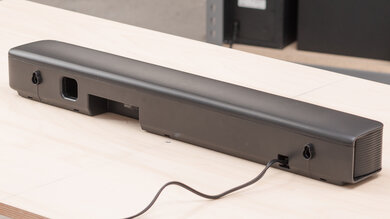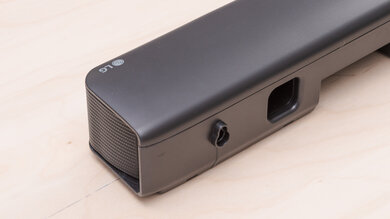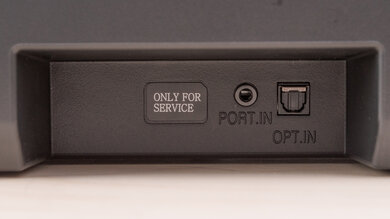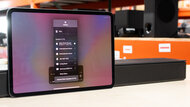The LG SK1 is a 2.0 entry-level soundbar with overall sub-par performance. It doesn't have a wireless sub and it struggles to produce a low, deep, and extended bass. On the upside, it does a decent job reproducing voices, making it ideal for dialogue-heavy content like podcasts and TV shows. This soundbar is well-built, but it's lacking a lot of connectivity options. You can use it to play surround content; however, it doesn't support Atmos, so it won't provide the most immersive listening experience. It also doesn't get very loud, and it doesn't support DTS, which is disappointing.
Our Verdict
Overall, the LG SK1 soundbar has a sub-par performance. While this entry-level soundbar has a fairly neutral sound profile, it's noticeably lacking bass. It performs best with dialogue-heavy content like audiobooks and TV shows, but the lack of bass may be disappointing for movie and music lovers. It doesn't have a lot of customization features or connectivity options, either. While the bar supports surround content, it won't provide the most immersive experience. It also doesn't support Atmos.
-
Some EQ presets.
-
Very well-built.
-
Compact design.
-
Lacks bass.
-
Doesn't get very loud.
-
Very few connectivity options.
The LG SK1 soundbar is decent for dialogue-heavy content like podcasts and TV shows. The sound profile is neutral and well-balanced in the mid-range, which is typically the frequencies at which voices are reproduced. It doesn't have a dedicated center channel, so it may not sound as clear and accurate as some of the other soundbars we've tested. On the downside, it doesn't have a dialogue enhancement feature to help make voices sound even clearer. However, it has Bluetooth capabilities, so you can stream content from your phone or tablet to the bar wirelessly.
-
Supports Bluetooth.
-
Neutral and well-balanced mid-range.
-
Lacks bass.
-
Doesn't get very loud.
-
No dialogue enhancement feature.
The LG SK1 soundbar is sub-par for music. Overall, it has a fairly neutral sound profile, but it's noticeably lacking bass. It doesn't have a separate subwoofer, either. As a result, it may not be ideal for listening to bass-heavy music like hip-hop and EDM. On the upside, it should still do a decent job reproducing vocals. It also comes with two EQ presets, so you have some ability to customize your sound, although it's quite limited.
-
Some EQ presets.
-
Supports Bluetooth.
-
Neutral and well-balanced mid-range.
-
Lacks bass.
-
Doesn't get very loud.
The LG SK1 soundbar has a disappointing performance for movies. Its bass doesn't extend very low, so it doesn't do a good job reproducing the deep thumps and rumbles found in movie scores and action-packed scenes. Also, this soundbar doesn't get very loud, so it isn't ideal for use in large, crowded, or noisy environments. On the upside, it does support surround content. However, it downmixes it to stereo, so it won't provide as immersive of a listening experience as a soundbar with dedicated surround speakers. It also doesn't support Atmos or DTS content.
-
Supports surround content.
-
Lacks bass.
-
Doesn't get very loud.
-
No Atmos or DTS support.
- 5.8 Mixed Usage
- 6.4 Dialogue/TV Shows
- 6.1 Music
- 5.3 Movies
Changelog
- Updated Apr 06, 2021: Updated 'Auto-Volume' from 'No' to 'Yes'.
- Updated Apr 02, 2021: Converted to Test Bench 1.0.
- Updated Sep 22, 2020: The Dynamics tests have been reconducted due to a value input bug.
- Updated Aug 07, 2020: Review published.
- Updated Aug 03, 2020: Early access published.
Check Price
Compared To Other Soundbars
The LG SK1 soundbar is a 2.0 setup from LG's 2018 lineup. This simple, entry-level setup doesn't have as many features or connectivity options as some of the more premium bars in LG's lineup, like the LG SK10Y and the LG SK9Y. It doesn't support Atmos or DTS, and it doesn't have any HDMI ports. However, unlike some of the other 2.0 soundbars on the market, it supports surround content. See our recommendations for the best soundbars, the best soundbars for dialogue, and the best soundbars under $200.
The Sony HT-S100F is a better overall soundbar than the LG SK1. Both soundbars have a fairly neutral sound profile that lacks sub-bass; however, the Sony extends slightly deeper than the LG. This gives it a slightly better performance with bass-heavy music and movies. It gets much louder than the LG, and it has more sound enhancement features, such as dialogue enhancement. However, unlike the Sony, the LG comes with a few EQ presets.
The TCL Alto 5 is a better overall soundbar than the LG SK1. Both bars have a fairly well-balanced sound profile but lack deep, extended bass. However, the TCL has a slightly better bass performance than the LG, making it better suited for bass-heavy music and movies. The TCL also has a dialogue enhancement feature, which the LG lacks. Neither bar supports Atmos or DTS.
The LG SK1 is a slightly better soundbar than the Vizio SB2020n-G6 for some uses. The Vizio only supports PCM-format content, so it doesn't support Dolby Digital or surround content. As a result, the LG is a better choice for movie fans. The LG is better-built and it can be wall-mounted, unlike the Vizio. However, while both bars are lacking a bit of bass, the Vizio has a slightly more extended bass that may be preferred by some users.
The Sonos Arc is a better soundbar than the LG SK1. Unlike the 2.0 SK1, the 5.0.2 Arc supports Atmos content. The Sonos also has more sound enhancement features, including room correction and dialogue enhancement. It also has an eARC port, unlike the LG. The LG has less compression and distortion when played at max volume, so you might prefer this bar if you tend to crank up the volume.
The Bose Solo 5 is a better overall soundbar than the LG SK1. The Bose has a decent sound profile that lacks bass, but it still gets more bass than the LG. As a result, it does a slightly better job reproducing the low thumps and rumbles in bass-heavy music and movies. Both bars don't support Atmos or DTS. However, the LG has slightly more customization options than the Bose, thanks to its two EQ presets.
The Samsung HW-Q80R is a better soundbar overall than the LG SK1. The Samsung is a 5.1.2 setup that supports Dolby Atmos content and can provide a more immersive listening experience thanks to its two surround satellites. The 2.0 LG is more of an entry-level setup, and it doesn't have a dialogue enhancement feature or an eARC port, unlike the Samsung. The Samsung also has a better-balanced sound profile and a wider, more focused soundstage.
The JBL Link Bar is a better overall soundbar than the LG SK1. Both are lacking a deep and extended bass. However, the JBL's bass has a slightly better performance that enables it to better reproduce the deep thump and rumble in bass-heavy music and movies. It can also get louder than the LG, though there's a bit of compression at max volume. The JBL also has more customization options, including a dialogue enhancement feature, and far more connectivity options, making it much more versatile.
The LG SK1 is a better overall 2.0 soundbar than the BOMAKER Odine II. The LG is better built, its sound profile is more neutral, and it has a center channel. It can also downmix surround content into stereo, and it can support Dolby Digital over its Optical In port. However, the BOMAKER has a dialogue enhancement feature, and it can get louder, albeit with a bit more compression.
Test Results
This setup doesn't have an external subwoofer.
There aren't any satellites in this setup.
The LG SK1 has a mediocre stereo frequency response. It has a neutral sound profile in the mid and treble ranges, making it ideal for voice-heavy content. However, it's noticeably lacking bass. Its low-frequency extension is very high, meaning that it won't be able to reproduce the deep thump and rumble commonly found in bass-heavy music genres and movies. It also only has two EQ presets (Standard and Bass Blast) to help you customize the sound.
The LG SK1 has a sub-par stereo soundstage performance. The bar is small, and the soundstage sounds about as wide as the bar. While it has a decent focus, it sounds a bit diffused, so sounds seem to be coming from a more general area rather than an accurate pinpoint location.
Update 09/22/2020: We've discovered a value input bug that would cause the Dynamics box results to be slightly off. All soundbars reviewed since January 30th, 2020 have been updated.
The LG SK1 can only get decently loud, which might be disappointing if you want to use your soundbar in large rooms or crowded environments. On the upside, when the bar is played at max volume, there isn't a lot of compression, which is good.
The LG SK1's THD performance is good. At a normal listening volume, there isn't a lot of distortion, so you should get a clean and pure sound reproduction. There's a slight jump in THD when the bar is played at max volume. However, this shouldn't be too audible with real-life content.
The LG SK1 has okay overall center performance. It's a 2.0 setup, so it doesn't have a dedicated center speaker. Instead, it uses the left and right speakers to create a sound in the center, which won't sound as clear and accurate as a soundbar with a dedicated center channel. On the upside, the sound profile is still fairly neutral, making it suitable for dialogue-heavy content like podcasts and TV shows.
The LG SK1 has a poor surround performance. It downmixes surround content to a stereo signal, which won't sound as clear and real as a soundbar with discrete speakers. Surround objects may sound like they're coming from the front, instead of the sides or from behind, so it won't sound as immersive.
This soundbar doesn't support Atmos.
Update 04/06/2021: On the remote, there's a DRC (Dynamic Range Compression) On/Off button that helps balance the range between the loudest and quietest sounds, which can be useful if you're watching movies at night. As a result, we updated the results for 'Auto-Volume/Night Mode' from 'No' to 'Yes'.
The LG SK1 has a very bad selection of sound enhancement features. There's no room correction feature, so the bar may perform differently depending on the room you're in. You can't even enhance the dialogue to make it sound clearer at low volumes. On the upside, it does offer two EQ presets (Standard and Bass Blast), so you have some control over how the bar sounds.
The LG SK1 doesn't have a lot of inputs. There aren't any HDMI inputs, so you won't be able to use this soundbar as a hub for your other devices. The Optical Audio In port can be used for surround sound, though it doesn't have as many features as an HDMI ARC. You can also play music from your smartphone through the bar using the Aux port.
This soundbar doesn't have any HDMI ARC inputs.
This soundbar doesn't have any full HDMI inputs.
The LG SK1, like most soundbars, supports Dolby Digital over an optical connection. However, it doesn't support DTS, which may be disappointing if you like to watch Blu-ray movies.
The LG SK1 supports Bluetooth, so you can play content wirelessly from your phone or tablet. However, you won't be able to stream content to the bar using Wi-Fi, Chromecast built-in, or Apple AirPlay, which may be disappointing for some users.
The LG SK1 doesn't have an HDMI port, so it can't support high-signal passthrough. You won't be able to use the bar as a hub for your other devices, like your game console or your PC.
There aren't any controls on this soundbar, so you have to control it using the remote.
The LG SK1 has a very simple remote that allows you to adjust the volume, change the inputs, and turn the bar on and off. You can also use the remote to switch between the two EQ presets: Bass Blast and Standard mode. However, it can't act as a universal remote, so you won't be able to use it to control your whole home theater setup.
This soundbar doesn't have a companion app.
The LG SK1 turns off if the soundbar isn't connected to an external device and hasn't been used for 15 minutes. Also, it has limited IR support, so your TV remote can only control the volume and mute functions of the soundbar.
Comments
LG SK1: Main Discussion
Let us know why you want us to review the product here, or encourage others to vote for this product.

































